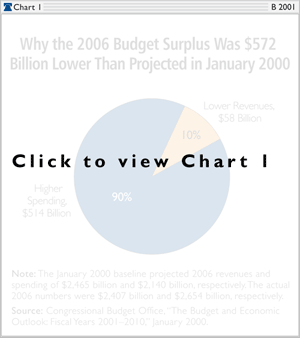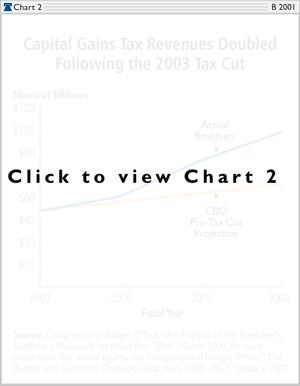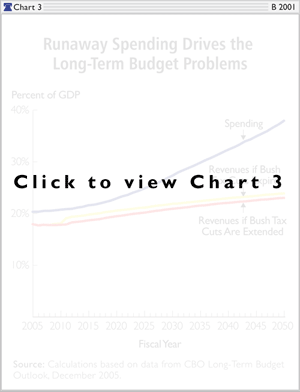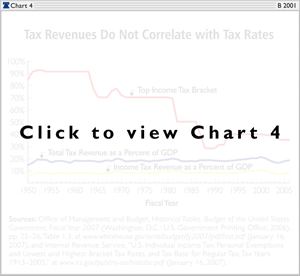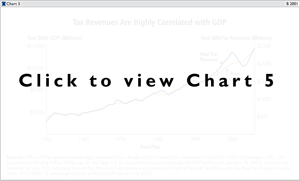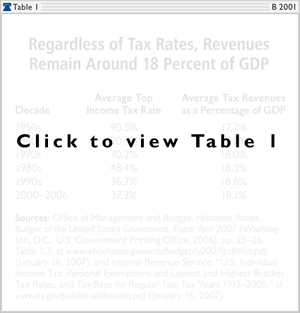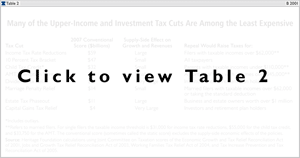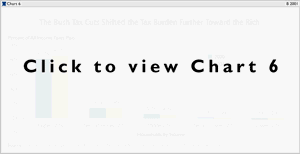The Democratic majority in the U.S. House of Representatives must decide whether to write a budget extending, expiring, or repealing the Bush tax cuts. These tax cuts have provided a convenient scapegoat for the nation's budget and economic challenges. Despite a 42 percent spending increase in 2001, critics charge that the tax cuts have starved popular programs. Despite surging economic growth and 5 million new jobs since 2003, critics also charge that the tax cuts have not helped the economy. Finally, despite making the income tax code more progressive, critics charge that the tax cuts have widened inequality.
Nearly all of the conventional wisdom about the Bush tax cuts is wrong. In reality:
- The tax cuts have not substantially reduced current tax revenues, which were in fact not far from the 2000 pre-tax cut baseline and over the 2003 pre-tax cut baseline in 2006;
- The increased child tax credit, 10 percent tax bracket, and fix of the alternative minimum tax (AMT) reduced tax revenues much more than most of the "tax cuts for the rich";
- Economic growth rates have more than doubled since the 2003 tax cuts; and
- The tax cuts shifted even more of the income tax burden toward the rich.
Setting optimal tax policy requires governing with facts rather than popular mythology, which is why it is important to set the record straight by debunking 10 myths about the Bush tax cuts.
|
Myth #1: Tax revenues remain low.
Fact: Tax revenues are above the historical average, even after the tax cuts.
Tax revenues in 2006 were 18.4 percent of gross domestic product (GDP), which is actually above the 20-year, 40-year, and 60-year historical averages.[1] The inflation-adjusted 20 percent tax revenue increase between 2004 and 2006 represents the largest two-year revenue surge since 1965-1967.[2] Claims that Americans are undertaxed by historical standards are patently false.
Some critics of President George W. Bush's tax policies concede that tax revenues exceed the historical average yet assert that revenues are historically low for economies in the fourth year of an expansion. Setting aside that some of these tax policies are partly responsible for that economic expansion, the numbers simply do not support this claim. Comparing tax revenues in the fourth fiscal year after the end of each of the past three recessions shows nearly equal tax revenues of:
- 18.4 percent of GDP in 1987,
- 18.5 percent of GDP in 1995, and
- 18.4 percent of GDP in 2006.[3]
While revenues as a percentage of GDP have not fully returned to pre-recession levels (20.9 percent in 2000), it is now clear that the pre-recession level was a major historical anomaly caused by a temporary stock market bubble.
Myth #2: The Bush tax cuts substantially reduced 2006 revenues and expanded the budget deficit.
Fact: Nearly all of the 2006 budget deficit resulted from additional spending above the baseline.
Critics tirelessly contend that America's swing from budget surpluses in 1998-2001 to a $247 billion budget deficit in 2006 resulted chiefly from the "irresponsible" Bush tax cuts. This argument ignores the historic spending increases that pushed federal spending up from 18.5 percent of GDP in 2001 to 20.2 percent in 2006.[4]
The best way to measure the swing from surplus to deficit is by comparing the pre-tax cut budget baseline of the Congressional Budget Office (CBO) with what actually happened. While the January 2000 baseline projected a 2006 budget surplus of $325 billion, the final 2006 numbers showed a $247 billion deficit-a net drop of $572 billion. This drop occurred because spending was $514 billion above projected levels, and revenues were $58 billion below (even after $188 billion in tax cuts). In other words, 90 percent of the swing from surplus to deficit resulted from higher-than-projected spending, and only 10 percent resulted from lower-than-projected revenues.[5] (See Chart 1.)
Furthermore, tax revenues in 2006 were actually above the levels projected before the 2003 tax cuts. Immediately before the 2003 tax cuts, the CBO projected a 2006 budget deficit of $57 billion, yet the final 2006 budget deficit was $247 billion. The $190 billion deficit increase resulted from federal spending that was $237 billion more than projected. Revenues were actually $47 billion above the projection, even after $75 billion in tax cuts enacted after the baseline was calculated.[6] By that standard, new spending was responsible for 125 percent of the higher 2006 budget deficit, and expanding revenues actually offset 25 percent of the new spending.
The 2006 tax revenues were not substantially far from levels projected before the Bush tax cuts. Despite estimates that the tax cuts would reduce 2006 revenues by $188 billion, they came in just $58 billion below the pre-tax cut revenue level projected in January 2000.[7]
The difference is even more dramatic with the pro-growth 2003 tax cuts. The CBO calculated that the post-March 2003 tax cuts would lower 2006 revenues by $75 billion, yet 2006 revenues came in $47 billion above the pre-tax cut baseline released in March 2003. This is not a coincidence. Tax cuts clearly played a significant role in the economy's performing better than expected and recovering much of the lost revenue.
Myth #3: Supply-side economics assumes that all tax cuts immediately pay for themselves.
Fact: It assumes replenishment of some but not necessarily all lost revenues.
Attempts to debunk solid theories often involve first mischaracterizing them as straw men. Critics often erroneously define supply-side economics as the belief that all tax cuts pay for themselves. They then cite tax cuts that have not fully paid for themselves as conclusive proof that supply-side economics has failed.
However, supply-side economics never contended that all tax cuts pay for themselves. Rather the Laffer Curve[8] (upon which much of the supply-side theory is based) merely formalizes the common-sense observations that:
- Tax revenues depend on the tax base as well as the tax rate;
- Raising tax rates discourages the taxed behavior and therefore shrinks the tax base, offsetting some of the revenue gains; and
- Lowering tax rates encourages the taxed behavior and expands the tax base, offsetting some of the revenue loss.
If policymakers intend cigarette taxes to discourage smoking, they should also expect high investment taxes to discourage investment and income taxes to discourage work. Lowering taxes encourages people to engage in the given behavior, which expands the base and replenishes some of the lost revenue. This is the "feedback effect" of a tax cut.
Whether or not a tax cut recovers 100 percent of the lost revenue depends on the tax rate's location on the Laffer Curve. Each tax has a revenue-maximizing rate at which future tax increases will reduce revenue. (This is the peak of the Laffer Curve.) Only when tax rates are above that level will reducing the tax rate actually increase revenue. Otherwise, it will replenish only a portion of the lost revenue.
How much feedback revenue a given tax cut will generate depends on the degree to which taxpayers adjust their behavior. Cutting sales and property tax rates generally induces smaller feedback effects because taxpayers do not respond by substantially expanding their purchases or home-buying. Income taxes have a higher feedback effect. Nobel Prize-winning economist Ed Prescott has shown a strong cross-national link between lower income tax rates and higher work hours.[9] Investment taxes have the highest feedback effects because investors quickly move to avoid higher-taxed investments. Not surprisingly, history shows that higher investment taxes deeply curtail investment and consequently raise little (if any) new revenue.
Yet, using the standard set by some, even a hypothetical tax cut that provides real tax relief to millions of families and entrepreneurs and creates enough new income to recover 95 percent of the estimated revenue loss would be considered a "failure" of supply-side economics and thus merit a full repeal.
Myth #4: Capital gains tax cuts do not pay for themselves.
Fact: Capital gains tax revenues doubled following the 2003 tax cut.
As previously stated, whether a tax cut pays for itself depends on how much people alter their behavior in response to the policy. Investors have been shown to be the most sensitive to tax policy, because capital gains tax cuts encourage enough new investment to more than offset the lower tax rate.
In 2003, capital gains tax rates were reduced from 20 percent and 10 percent (depending on income) to 15 percent and 5 percent. Rather than expand by 36 percent from the current $50 billion level to $68 billion in 2006 as the CBO projected before the tax cut, capital gains revenues more than doubled to $103 billion.[10] (See Chart 2.) Past capital gains tax cuts have shown similar results.
By encouraging investment, lower capital gains taxes increase funding for the technologies, businesses, ideas, and projects that make workers and the economy more productive. Such investment is vital for long-term economic growth.
Because investors are tax-sensitive, high capital gains tax rates are not only bad economic policy, but also bad budget policy.
Myth #5: The Bush tax cuts are to blame for the projected long-term budget deficits.
Fact: Projections show that entitlement costs will dwarf the projected large revenue increases.
The unsustainability of America's long-term budget path is well known. However, a common misperception blames the massive future budget deficits on the 2001 and 2003 tax cuts. In reality, revenues will continue to increase above the historical average yet be dwarfed by historic entitlement spending increases. (See Chart 3.)
For the past half-century, tax revenues have generally stayed within 1 percentage point of 18 percent of GDP. The CBO projects that, even if all 2001 and 2003 tax cuts are made permanent, revenues will stillincrease from 18.4 percent of GDP today to 22.8 percent by 2050, not counting any feedback revenues from their positive economic impact. It is projected that repealing the Bush tax cuts would nudge 2050 revenues up to 23.7 percent of GDP, not counting any revenue losses from the negative economic impact of the tax hikes.[11] In effect, the Bush tax cut debate is whether revenues should increase by 4.4 percent or 5.3 percent of GDP.
Spending has remained around 20 percent of GDP for the past half-century. However, the coming retirement of the baby boomers will increase Social Security, Medicare, and Medicaid spending by a combined 10.5 percent of GDP. Assuming that this causes large budget deficits and increased net spending on interest, federal spending could surge to 38 percent of GDP and possibly much higher.[12]
Overall, revenues are projected to increase from 18 percent of GDP to almost 23 percent. Spending is projected to increase from 20 percent of GDP to at least 38 percent. Even repealing all of the 2001 and 2003 cuts would merely shave the projected budget deficit of 15 percent of GDP by less than 1 percentage point, and that assumes no negative feedback from raising taxes. Clearly, the French-style spending increases, not tax policy, are the problem. Lawmakers should focus on getting entitlements under control.
Myth #6: Raising tax rates is the best way to raise revenue.
Fact: Tax revenues correlate with economic growth, not tax rates.
Many of those who desire additional tax revenues regularly call on Congress to raise tax rates, but tax revenues are a function of two variables: tax rates and the tax base. The tax base typically moves in the opposite direction of the tax rate, partially negating the revenue impact of tax rate changes. Accordingly, Chart 4 shows little correlation between tax rates and tax revenues. Since 1952, the highest marginal income tax rate has dropped from 92 percent to 35 percent, and tax revenues have grown in inflation-adjusted terms while remaining constant as a percent of GDP.
Chart 5 shows the nearly perfect correlation between GDP and tax revenues. Despite major fluctuations in income tax rates, long-term tax revenues have grown at almost exactly the same rate as GDP, remaining between 17 percent and 20 percent of GDP for 46 of the past 50 years. Table 1 shows that the top marginal income tax rate topped 90 percent during the 1950s and that revenues averaged 17.2 percent of GDP. By the 1990s, the top marginal income tax rate averaged just 36 percent, and tax revenues averaged 18.3 percent of GDP. Regardless of the tax rate, tax revenues have almost always come in at approximately 18 percent of GDP.[13]
Since revenues move with GDP, the common-sense way to increase tax revenues is to expand the GDP. This means that pro-growth policies such as low marginal tax rates (especially on work, savings, and investment), restrained federal spending, minimal regulation, and free trade would raise more tax revenues than would be raised by self-defeating tax increases. America cannot substantially increase tax revenue with policies that reduce national income.
Myth #7: Reversing the upper-income tax cuts would raise substantial revenues.
Fact: The low-income tax cuts reduced revenues the most.
Many critics of tax cuts nonetheless support extending the increased child tax credit, marriage penalty relief, and the 10 percent income tax bracket because these policies strongly benefit low-income tax families. They also support annually adjusting the alternative minimum tax exemption for inflation to prevent a massive broad-based tax increase. These critics assert that repealing the tax cuts for upper-income individuals and investors and bringing back the pre-2001 estate tax levels can raise substantial revenue. Once again, the numbers fail to support this claim.
In 2007, according to CBO and Joint Committee on Taxation data, the increased child tax credit, marriage penalty relief, 10 percent bracket, and AMT fix will have a combined budgetary effect of $114 billion.[14] (See Table 2.) These policies do not have strong supply-side effects to minimize that effect.
By comparison, the more maligned capital gains, dividends, and estate tax cuts are projected to reduce 2007 revenues by just $36 billion even before the large and positive supply-side effects are incorporated. Thus, repealing these tax cuts would raise very little revenue and could possibly even reduce federal tax revenue. Such tax increases would certainly reduce the savings and investment vital to economic growth.
The individual income tax rate reductions come to $59 billion in 2007 and are not really a tax cut for the rich. All families with taxable incomes over $62,000 (and single filers over $31,000) benefit. Repealing this tax cut would reduce work incentives and raise taxes on millions of families and small businesses, thereby harming the economy and minimizing any new revenues.
Myth #8: Tax cuts help the economy by "putting money in people's pockets."
Fact: Pro-growth tax cuts support incentives for productive behavior.
Government spending does not "pump new money into the economy" because government must first tax or borrow that money out of the economy. Claims that tax cuts benefit the economy by "putting money in people's pockets" represent the flip side of the pump-priming fallacy. Instead, the right tax cuts help the economy by reducing government's influence on economic decisions and allowing people to respond more to market mechanisms, thereby encouraging more productive behavior.
The Keynesian fallacy is that government spending injects new money into the economy, but the money that government spends must come from somewhere. Government must first tax or borrow that money out of the economy, so all the new spending just redistributes existing income. Similarly, the money for tax rebates—which are also touted as a way to inject money into the economy—must also come from somewhere, with government either spending less or borrowing more. In both cases, no new spending is added to the economy. Rather, the government has just transferred it from one group (e.g., investors) in the economy to another (e.g., consumers).
Some argue that certain tax cuts, such as tax rebates, can transfer money from savers to spenders and therefore increase demand. This argument assumes that the savers have been storing their savings in their mattresses, thereby removing it from the economy. In reality, nearly all Americans either invest their savings, thereby financing businesses investment, or deposit the money in banks, which quickly lend it to others to spend or invest. Therefore, the money is spent by someone whether it is initially consumed or saved. Thus, tax rebates create no additional economic activity and cannot "prime the pump."
This does not mean tax policy cannot affect economic growth. The right tax cuts can add substantially to the economy's supply side of productive resources: capital and labor. Economic growth requires that businesses efficiently produce increasing amounts of goods and services, and increased production requires consistent business investment and a motivated, productive workforce. Yet high marginal tax rates—defined as the tax on the next dollar earned—serve as a disincentive to engage in such activities. Reducing marginal tax rates on businesses and workers increases the return on working, saving, and investing, thereby creating more business investment and a more productive workforce, both of which add to the economy's long-term capacity for growth.
Yet some propose demand-side tax cuts to "put money in people's pockets" and "get people to spend money." The 2001 tax rebates serve as an example: Washington borrowed billions from investors and then mailed that money to families in the form of $600 checks. Predictably, this simple transfer of existing wealth caused a temporary increase in consumer spending and a corresponding decrease in investment but led to no new economic growth. No new wealth was created because the tax rebate was unrelated to productive behavior. No one had to work, save, or invest more to receive a rebate. Simply redistributing existing wealth does not create new wealth.
In contrast, marginal tax rates were reduced throughout the 1920s, 1960s, and 1980s. In all three decades, investment increased, and higher economic growth followed. Real GDP increased by 59 percent from 1921 to 1929, by 42 percent from 1961 to 1968, and by 31 percent from 1982 to 1989.[15] More recently, the 2003 tax cuts helped to bring about strong economic growth for the past three years.
Policies which best support work, saving, and investment are much more effective at expanding the economy's long-term capacity for growth than those that aim to put money in consumers' pockets.
Myth #9: The Bush tax cuts have not helped the economy.
Fact: The economy responded strongly to the 2003 tax cuts.
The 2003 tax cuts lowered income, capital gains, and dividend tax rates. These policies were designed to increase market incentives to work, save, and invest, thus creating jobs and increasing economic growth. An analysis of the six quarters before and after the 2003 tax cuts (a short enough time frame to exclude the 2001 recession) shows that this is exactly what happened (see Table 3):
- GDP grew at an annual rate of just 1.7 percent in the six quarters before the 2003 tax cuts. In the six quarters following the tax cuts, the growth rate was 4.1 percent.
- Non-residential fixed investment declined for 13 consecutive quarters before the 2003 tax cuts. Since then, it has expanded for 13 consecutive quarters.
The S&P 500 dropped 18 percent in the six quarters before the 2003 tax cuts but increased by 32 percent over the next six quarters. Dividend payouts increased as well. - The economy lost 267,000 jobs in the six quarters before the 2003 tax cuts. In the next six quarters, it added 307,000 jobs, followed by 5 million jobs in the next seven quarters.
- The economy lost 267,000 jobs in the six quarters before the 2003 tax cuts. In the next six quarters, it added 307,000 jobs, followed by 5 million jobs in the next seven quarters.[16]
Critics contend that the economy was already recovering and that this strong expansion would have occurred even without the tax cuts. While some growth was naturally occurring, critics do not explain why such a sudden and dramatic turnaround began at the exact moment that these pro-growth policies were enacted. They do not explain why business investment, the stock market, and job numbers suddenly turned around in spring 2003. It is no coincidence that the expansion was powered by strong investment growth, exactly as the tax cuts intended.
The 2003 tax cuts succeeded because of the supply-side policies that critics most oppose: cuts in marginal income tax rates and tax cuts on capital gains and dividends. The 2001 tax cuts that were based more on demand-side tax rebates and redistribution did not significantly increase economic growth.
Myth #10: The Bush tax cuts were tilted toward the rich.
Fact: The rich are now shouldering even more of the income tax burden.
Popular mythology also suggests that the 2001 and 2003 tax cuts shifted more of the tax burden toward the poor. While high-income households did save more in actual dollars than low-income households, they did so because low-income households pay so little in income taxes in the first place. The same 1 percent tax cut will save more dollars for a millionaire than it will for a middle-class worker simply because the millionaire paid more taxes before the tax cut.
In 2000, the top 60 percent of taxpayers paid 100 percent of all income taxes. The bottom 40 percent collectively paid no income taxes. Lawmakers writing the 2001 tax cuts faced quite a challenge in giving the bulk of the income tax savings to a population that was already paying no income taxes.
Rather than exclude these Americans, lawmakers used the tax code to subsidize them. (Some economists would say this made that group's collective tax burden negative.)First, lawmakers lowered the initial tax brackets from 15 percent to 10 percent and then expanded the refundable child tax credit, which, along with the refundable earned income tax credit (EITC), reduced the typical low-income tax burden to well below zero. As a result, the U.S. Treasury now mails tax "refunds" to a large proportion of these Americans that exceed the amounts of tax that they actually paid. All in all, the number of tax filers with zero or negative income tax liability rose from 30 million to 40 million, or about 30 percent of all tax filers.[17] The remaining 70 percent of tax filers received lower income tax rates, lower investment taxes, and lower estate taxes from the 2001 legislation.
Consequently, from 2000 to 2004, the share of all individual income taxes paid by the bottom 40 percent dropped from zero percent to –4 percent, meaning that the average family in those quintiles received a subsidy from the IRS. (See Chart 6.) By contrast, the share paid by the top quintile of households (by income) increased from 81 percent to 85 percent.
Expanding the data to include all federal taxes, the share paid by the top quintile edged up from 66.6 percent in 2000 to 67.1 percent in 2004, while the bottom 40 percent's share dipped from 5.9 percent to 5.4 percent. Clearly, the tax cuts have led to the rich shouldering more of the income tax burden and the poor shouldering less.[18]
Conclusion
The 110th Congress will be serving when the first of 77 million baby boomers receive their first Social Security checks in 2008. The subsequent avalanche of Social Security, Medicare, and Medicaid costs for these baby boomers will be the greatest economic challenge of this era.
This should be the budgetary focus of the 110th Congress rather than repealing Bush tax cuts or allowing them to expire. Repealing the tax cuts would not significantly increase revenues. It would, however, decrease investment, reduce work incentives, stifle entrepreneurialism, and reduce economic growth. Lawmakers should remember that America cannot tax itself to prosperity.
Brian M. Riedl is Grover M. Hermann Fellow in Federal Budgetary Affairs in the Thomas A. Roe Institute for Economic Policy Studies at The Heritage Foundation.

